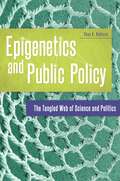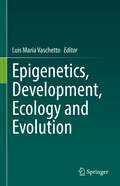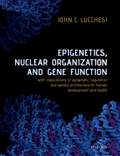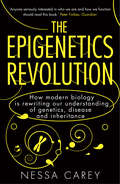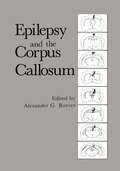- Table View
- List View
Epigenetics and Proteomics of Leukemia: A Synergy of Experimental Biology and Computational Informatics
by R¯uta Navakauskien˙e Dalius Navakauskas Veronika Borutinskait˙e Dalius Matuzevi˘ciusThis book reviews the current state of epigenetics and proteomics of leukemia and introduces the methods that are important to process and evaluate these factors in leukemia. In particular, epigenetic modifiers and their inhibitors in leukemia treatment as well as approaches to the epigenetic treatment of leukemia are covered. Various computational methods for proteome analysis are also described in detail, including 2DE fractionation and visualization, proteomic data processing, image acquisition and data anlaysis, and more. Protein localization in leukemia is also covered, in addition to the future of leukemia therapy. Epigenetics and Proteomics of Leukemia is an ideal book for advanced biomedical scientists and students, medical doctors and students, bioinformatics and health informatics researchers, computational biologists, structural biologists, systems biologists, and bioengineers.
Epigenetics and Public Policy: The Tangled Web of Science and Politics
by Shea K. RobisonThe exciting field of epigenetics offers novel and unanticipated science-based insights into human origins and development. This book presents one of the first detailed examinations of the political implications of epigenetics.Epigenetics—the study of internal and environmental factors that affect how genes are turned on or off and how cells read those genes—is a rapidly emerging science akin to genetics that introduces a number of novel and unexpected biological explanations of human origins and development. It also poses fundamental challenges to many of the assumptions of the prevailing science of genetics. When science changes, how does public policy respond?This book comprehensively considers the political implications of the emerging science of epigenetics in specific policy domains, addressing the intersections of epigenetics with cancer, obesity, the environment, and the law. Author Shea K. Robison carefully navigates the messy history of genetics and epigenetics in order to explore what changes in public policy might come in the age of a new scientific frontier. Readers will understand how new findings in epigenetic research and increased acceptance of epigenetic science may lead to paradigm shifts in cancer prevention and treatment, significantly different policy solutions for combating obesity, and revised statutes of limitations and laws regarding civil and corporate liability and wrongful life.
Epigenetics and Public Policy: The Tangled Web of Science and Politics
by Shea K. RobisonThe exciting field of epigenetics offers novel and unanticipated science-based insights into human origins and development. This book presents one of the first detailed examinations of the political implications of epigenetics.Epigenetics—the study of internal and environmental factors that affect how genes are turned on or off and how cells read those genes—is a rapidly emerging science akin to genetics that introduces a number of novel and unexpected biological explanations of human origins and development. It also poses fundamental challenges to many of the assumptions of the prevailing science of genetics. When science changes, how does public policy respond?This book comprehensively considers the political implications of the emerging science of epigenetics in specific policy domains, addressing the intersections of epigenetics with cancer, obesity, the environment, and the law. Author Shea K. Robison carefully navigates the messy history of genetics and epigenetics in order to explore what changes in public policy might come in the age of a new scientific frontier. Readers will understand how new findings in epigenetic research and increased acceptance of epigenetic science may lead to paradigm shifts in cancer prevention and treatment, significantly different policy solutions for combating obesity, and revised statutes of limitations and laws regarding civil and corporate liability and wrongful life.
Epigenetics and Responsibility: Ethical Perspectives
by Emma Moormann, Anna Smajdor and Daniela CutasEPUB and EPDF available Open Access under CC-BY-NC-ND licence. We tend to hold people responsible for their choices, but not for what they can’t control: their nature, genes or biological makeup. This thought-provoking collection redefines the boundaries of moral responsibility. It shows how epigenetics reveals connections between our genetic make-up and our environment. The essays challenge established notions of human nature and the nature/nurture divide and suggest a shift in focus from individual to collective responsibility. Uncovering the links between our genetic makeup, environment and experiences, this is an important contribution to ongoing debates on ethics, genetics and responsibility.
Epigenetics and Responsibility: Ethical Perspectives
by Emma Moormann Anna Smajdor Daniela CutasEPUB and EPDF available Open Access under CC-BY-NC-ND licence. We tend to hold people responsible for their choices, but not for what they can’t control: their nature, genes or biological makeup. This thought-provoking collection redefines the boundaries of moral responsibility. It shows how epigenetics reveals connections between our genetic make-up and our environment. The essays challenge established notions of human nature and the nature/nurture divide and suggest a shift in focus from individual to collective responsibility. Uncovering the links between our genetic makeup, environment and experiences, this is an important contribution to ongoing debates on ethics, genetics and responsibility.
Epigenetics: Development and Disease (Subcellular Biochemistry #61)
by Tapas K. KunduEpigenetics fine-tunes the life processes dictated by DNA sequences, but also kick-starts pathophysiological processes including diabetes, AIDS and cancer. This volume tracks the latest research on epigenetics, including work on new-generation therapeutics.
Epigenetics, Development, Ecology and Evolution
by Luis María VaschettoEpigenetic modifications comprise heritable gene expression changes that occur without alteration of the DNA sequence and 'co-act' with genetic factors to shape development processes and evolutionary trajectories. Multicellular organisms receive different types of environmental stimuli/stresses that trigger epigenetic modifications during development. These environmentally driven mechanisms represent an underlying cause of phenotypic diversity, especially in metazoans. This book aims to present some of the latest epigenetic insights into the development of metazoans (including humans) as an intersection between their ecology and evolution.
Epigenetics - A Different Way of Looking at Genetics (Epigenetics and Human Health)
by Walter Doerfler Petra BöhmThis book presents epigenetics research as a new way of looking at genetics. Topics range from basic epigenetics mechanisms to development of cells and organisms and the biological basis of diseases. In addition the book focuses on immunology and the role of viruses in epigenetics. The last part of the book highlights proteins and peptides as epigenetic modulators.
Epigenetics in Allergy and Autoimmunity (Advances in Experimental Medicine and Biology #1253)
by Christopher Chang Qianjin LuThis book will address the growing roles of epigenetics in disease pathogenesis, and review the contribution of epigenetic modifications to disease onset and progression. The roles that epigenetics plays in facilitating effects of the environment on allergy and immunologic diseases will be reviewed. The book is divided into three parts – the first is an introduction to epigenetics and the methods that have been developed to study epigenetics, the second addresses epigenetics in allergic diseases and the third part will cover epigenetics in autoimmune diseases. With the rapid expansion of knowledge of how genes are regulated and how this regulation affects disease phenotypes, this book will be attractive to experienced researchers as well as those just launching an epigenetics research program. It will also be of interest to allergist, immunologists, rheumatologists and dermatologist who are engaged in clinical practice as a resource for understanding the basis for personalized and precision medicine. For example, the role that epigenetics plays in the pathogenesis in various allergic and autoimmune disorders and how this determines disease phenotypes will be covered extensively in this book. This book will thus help fill the gap in available resources on epigenetics in allergy and autoimmune diseases.
Epigenetics in Biological Communication
by Guenther WitzanyEvery cell, tissue, organ and organism is competent to use signs to exchange information reaching common coordinations and organisations of both single cell and group behavior. These sign-mediated interactions we term biological communication. The regulatory system that works in development, morphology, cell fate and identity, physiology, genetic instructions, immunity, memory/learning, physical and mental disease depends on epigenetic marks. The communication of cells, persistent viruses and their defectives such as mobile genetic elements and RNA networks ensures both the transport of regulatory instructions and the reprogramming of these instructions. But how are the different states of the epigenome orchestrated? The epigenetic pathways respond to various signaling cues such as DNA methylation, histone variants, histone modifications, chromatin structure, nucleosome remodeling, and epigenetic interactions. Epigenetic signals are responsible for the establishment, maintenance and reversal of transcriptional states that are fundamental for the cell's ability to memorize past events, such as changes in the external environment, socio-sphere or developmental cues. External signals trigger changes in the epigenome, allowing cells to respond dynamically. Internal signals direct activities that are necessary for body maintenance, and repairing damaged tissues and organs. With the emergence of epigenetic memory, organisms can fix historical and context dependent impressive experiences. Evolution from now on learnt to learn. Learning means organisms can avoid reproduction of always the same. This is key to adaptation. However, inheritance of acquired characteristics is only one of the many examples of the explanatory power of epigenetics. Behavioral epigenetics demonstrates the way in which environmental and social experiences produce individual differences in behaviour, cognition, personality, and mental health. This book assembles experts to outline the various motifs of all kinds of epigenetic regulation of cells throughout their lives.
Epigenetics in Cancer (Life Science Research Fundamentals)
by WileyEpigenetics is the study of heritable changes in gene expression or cellular phenotype, caused by mechanisms other than changes in the DNA sequence. Examples include DNA methylation and histone modification. These changes may remain through cell divisions and multiple generations. Epigenetic differences among individuals may account for some of the differences between monozygotic (identical) twins. Aberrant DNA methylation is also frequently associated with human aging and diseases, such as cancer. This collection of overviews and laboratory protocols provides crucial, distilled information about the roles of epigenetics in cancer development. The overviews are geared for research scientists who need to learn more about the current understanding of epigenetic variation in humans and how the processes of DNA methylation and histone modification are regulated. The protocols give step-by-step instructions on how to detect DNA methylation using various methods such as MAPit, CHARM (arrays) and methylation-specific PCR. This e-book — a curated collection from eLS, WIREs, and Current Protocols — offers a fantastic introduction to the fields of genetics, genomics, and oncogenesis for students or interdisciplinary collaborators.
Epigenetics in Cardiac Disease (Cardiac and Vascular Biology #1)
by Johannes Backs Timothy A. McKinseyThis book describes important advances in our understanding of how environmental conditions affect cardiac gene expression through epigenetic mechanisms. Further, it discusses the roles of chromatin modifications (in particular DNA methylation and histone modifications) and of chromatin regulators in the context of cardiac diseases. The book provides readers with an overview of our current understanding of epigenetic regulation in the heart, and will stimulate further research in this exciting field. Edited and written by internationally respected experts, it addresses the needs of professors, students and researchers working in the fields of cardiac biology and epigenetics.
Epigenetics in Oncology (Cancer Treatment and Research #190)
by Jianjun Chen G. Greg Wang Jun LuThis book addresses Epigenetics in Cancer and covers the most recent advances in RNA/histone/DNA epigenetics in Oncology. RNA/histone/DNA epigenetics have been shown to play pivotal roles in cancer initiation, progression, maintenance and drug response/resistance, tumor microenvironment, cancer stem cell self-renewal, cancer metabolism, and tumor immune evasion. In particular, research in RNA cancer epigenetics has made impressive progress in the last few years.Individual chapters in Part I (focusing on RNA epigenetics) are devoted to RNA modifications in Cancer Metabolism and Microenvironment, Cancer Stem Cell Biology, Immune Surveillance, Solid Tumors and Tumor Immunity, and Hematopoietic Malignancies, as well as to RNA editing in Cancer. Chapters in Part II and III of the book focus on histone epigenetics and DNA epigenetics, respectively.By familiarizing readers with the latest developments in this complex and challenging field, the book offers a valuable resource for scientists, graduate students and clinicians alike.
Epigenetics in Plants of Agronomic Importance: Transcriptional Regulation and Chromatin Remodelling in Plants
by Raúl Alvarez-Venegas Clelia De-la-Peña Juan Armando Casas-MollanoOver the past few decades, chromatin modulation has emerged as an important regulator of gene expression. This second edition provides detailed information on the epigenetic mechanisms in plants, illustrating the value of this research in plants of agronomic importance. It examines recent advances regarding plants’ epigenetic regulation in response to abiotic and biotic types of stress; the epigenetic basis of plant immunity; evolution and functions of plant histones; epigenetic variation and plant breeding; and epigenome editing and crop improvement. The content is intended to promote the development of future biotechnologies to manipulate and selectively activate/inhibit proteins and metabolic pathways to counter pathogens, to treat important diseases, and to increase crop productivity. The development of new fields, like epigenome editing and RNA epigenetics, will certainly improve our understanding of currently known epigenetic modifications and their roles in e.g. host-pathogen interactions, crop productivity, and in response to environmental stimuli. This volume contains twelve new/revised chapters, written by an international team of experts on plant epigenetics, and addresses the needs of researchers and professionals in the fields of agronomics, crop breeding, epigenetics, plant biochemistry, plant developmental biology, and related disciplines.
Epigenetics in Plants of Agronomic Importance: Transcriptional Regulation and Chromatin Remodelling in Plants
by Raúl Alvarez-Venegas Clelia De la Peña Juan Armando Casas-MollanoOver the past decades, chromatin remodelling has emerged as an important regulator of gene expression and plant defense. This book provides a detailed understanding of the epigenetic mechanisms involved in plants of agronomic importance. The information presented here is significant because it is expected to provide the knowledge needed to develop in the future treatments to manipulate and selectively activate/inhibit proteins and metabolic pathways to counter pathogens, to treat important diseases and to increase crop productivity. New approaches of this kind and the development of new technologies will certainly increase our knowledge of currently known post-translational modifications and facilitate the understanding of their roles in, for example, host-pathogen interactions and crop productivity. Furthermore, we provide important insight on how the plant epigenome changes in response to developmental or environmental stimuli, how chromatin modifications are established and maintained, to which degree they are used throughout the genome, and how chromatin modifications influence each another.
Epigenetics, Nuclear Organization & Gene Function: With implications of epigenetic regulation and genetic architecture for human development and health
by John C. LucchesiEpigenetics is the study of heritable changes in gene function that do not involve changes in the DNA sequence. These changes, consisting principally of DNA methylation, histone modifications, and non-coding RNAs, maintain or modulate the initial impact of regulatory factors that recognize and associate with particular genomic sequences. Epigenetic modifications are manifest in all aspects of normal cellular differentiation and function, but they can also have damaging effects that result in pathologies such as cancer. Research is continuously uncovering the role of epigenetics in a variety of human disorders, providing new avenues for therapeutic interventions and advances in regenerative medicine. This book's primary goal is to establish a framework that can be used to understand the basis of epigenetic regulation and to appreciate both its derivation from genetics and interdependence with genetic mechanisms. A further aim is to highlight the role played by the three-dimensional organization of the genetic material itself (the complex of DNA, histones and non-histone proteins referred to as chromatin), and its distribution within a functionally compartmentalized nucleus. This architectural organization of the genome plays a major role in the subsequent retrieval, interpretation, and execution of both genetic and epigenetic information.
The Epigenetics Revolution: How Modern Biology is Rewriting our Understanding of Genetics, Disease and Inheritance
by Nessa Carey'A book that would have had Darwin swooning - anyone seriously interested in who we are and how we function should read this.' Guardian At the beginning of this century enormous progress had been made in genetics. The Human Genome Project finished sequencing human DNA. It seemed it was only a matter of time until we had all the answers to the secrets of life on this planet. The cutting-edge of biology, however, is telling us that we still don't even know all of the questions. How is it that, despite each cell in your body carrying exactly the same DNA, you don't have teeth growing out of your eyeballs or toenails on your liver? How is it that identical twins share exactly the same DNA and yet can exhibit dramatic differences in the way that they live and grow? It turns out that cells read the genetic code in DNA more like a script to be interpreted than a mould that replicates the same result each time. This is epigenetics and it's the fastest-moving field in biology today. The Epigenetics Revolution traces the thrilling path this discipline has taken over the last twenty years. Biologist Nessa Carey deftly explains such diverse phenomena as how queen bees and ants control their colonies, why tortoiseshell cats are always female, why some plants need a period of cold before they can flower, why we age, develop disease and become addicted to drugs, and much more. Most excitingly, Carey reveals the amazing possibilities for humankind that epigenetics offers for us all - and in the surprisingly near future.
Epigenetics Territory and Cancer
by Parvin MehdipourThis book explores epigenetic strategies, bridging fundamental cancer epigenetics, different paradigms in tumor genetics and translational understanding for both the clinic and improved lifestyles. The work provides target-based insights for treating different types of cancers and presents research on evolutionary epigenetics, introducing ‘Medical Epi- Anthropology’ and ‘Cancer Epi-Anthropology’. Translating multi-disciplinary research into therapeutic design is at the core of this book. Readers may explore how cancer management involves unmasking the involved networks and the interactive status of different genes to achieve the appropriate methylome based therapy. Early chapters explore fundamental aspects and brain tumours, whilst later chapters investigate breast cancer and various other cancers, and the final chapter presents an evolutionary insight in cancer epigenetics, considering that the epigene is beyond DNA methylation, RNA interference and histone modification in cancer development. This book will be of interest to researchers in different medical and scientific fields, including clinical management (diagnosis, prognosis, prediction, prevention, and guidelines), genetic education, nutrition and nutrigenomics, industrial chemistry, and drug innovation. Because of the unique bridging between science and medicine this book will also be useful as an educational and translational research package.
Epigenetik des Menschen
by Carsten Carlberg Ferdinand MolnárDie Ansicht „Es liegt alles in unseren Genen und wir können es nicht ändern“ hat sich in den letzten 150 Jahren seit Gregor Mendels Experimenten mit blühenden Erbsenpflanzen entwickelt. Es gibt jedoch eine besondere Form der Genetik, die Epigenetik, bei der unsere Gene nicht verändert werden, sondern geregelt wird, wie und wann sie genutzt werden. Unsere Umwelt und Lebensstilentscheidungen beeinflussen die Epigenetik unserer Zellen und Organe, d. h. die Epigenetik verändert sich dynamisch während unseres gesamten Lebens. Wir haben also die Möglichkeit, unsere Epigenetik sowohl positiv als auch negativ zu verändern.In diesem Buch wird auf molekularer Ebene erklärt, wie unser Genom mit Umweltsignalen verbunden ist. Es zeigt auf, dass die epigenetische Programmierung ein Lernprozess ist, der zu einem epigenetischen Gedächtnis in jeder Zelle unseres Körpers führt. Die zentrale Bedeutung der Epigenetik während der Embryogenese und der zellulären Differenzierung sowie beim Alterungsprozess und dem Risiko für die Entstehung von Krebs werden erörtert. Darüber hinaus wird die Rolle des Epigenoms als molekularer Speicher für zelluläre Ereignisse nicht nur im Gehirn, sondern auch in Stoffwechselorganen und im Immunsystem beschrieben.Das Buch ist die Übersetzung des Lehrbuchs „Human Epigenetics: How Science Works“ (ISBN 978-3-030-22907-8) der Autoren. In den ersten fünf Kapiteln werden die molekularen Grundlagen der Epigenetik erläutert, während die folgenden sieben Kapitel Beispiele für die Auswirkungen der Epigenetik auf die menschliche Gesundheit und Krankheit liefern.
The Epigenome: Molecular Hide and Seek
by Stephan Beck Alexander OlekThis is the first book that describes the role of the Epigenome (cytosine methylation) in the interplay between nature and nurture. It focuses and stimulates interest in what will be one of the most exciting areas of post-sequencing genome science: the relationship between genetics and the environment. Written by the most reputable authors in the field, this book is essential reading for researchers interested in the science arising from the human genome sequence and its implications on health care, industry and society.
Epigenome Editing: Methods and Protocols (Methods in Molecular Biology #2842)
by Albert Jeltsch Marianne G. RotsThis second volume details new and updated methods covering applications of epigenome editing. Chapters guide readers through general and topical reviews, DNA-binding devices, optimization of the effector domains, readout of epigenome marks, and approaches for delivery at the cellular and organismal level. Written in the highly successful Methods in Molecular Biology series format, chapters include introductions to their respective topics, lists of the necessary materials and reagents, step-by-step, readily reproducible laboratory protocols, and key tips on troubleshooting and avoiding known pitfalls. Authoritative and cutting-edge, Epigenome Editing: Methods and Protocols, Second Editon aims to ensure successful results in the further study of this vital field.
Epigenomics: Methods and Protocols (Methods in Molecular Biology #2577)
by Izuho Hatada Takuro HoriiThis detailed volume provides a comprehensive collection of protocols for epigenomic research, powering our ability to analyze epigenetic modifications across the entire genome. Beginning with methods used to investigate epigenomic modifications such as DNA methylation, histone modifications, and chromatin structure, the book continues with methods for manipulating the epigenome, including platforms for epigenome editing, inducible systems for epigenome editing, and epigenetically modified animals. Written for the highly successful Methods in Molecular Biology series, chapters feature introductions to their respective topics, lists of the necessary materials and reagents, step-by-step and readily reproducible laboratory protocols, and tips on troubleshooting and avoiding known pitfalls. Authoritative and practical, Epigenomics: Methods and Protocols serves as an ideal resource for researchers looking to further expand the utility and scope of epigenomics research.
Epilepsy: The Intersection of Neurosciences, Biology, Mathematics, Engineering, and Physics
by Ivan Osorio Hitten P. Zaveri Mark G. Frei Susan ArthursEpilepsy, one of the most prevalent neurological disorders, affects approximately 1% (greater than 60 million) of the world's population. In an estimated 20 million of these patients, seizures are not controlled even by multiple anti-seizure drugs, and are extremely difficult to predict. Epilepsy: The Intersection of Neurosciences, Biology, Mathema
Epilepsy and the Corpus Callosum
by Alexander G. ReevesInJuly 1982 the first Dartmouth workshop on the corpus callosum took place. A nucleus of basic and clinical scientists was convened to give progress reports of their work on the corpus callosum. This text was subsequently compiled by the various participants from these reports modified by a stimulating cross fertilization of ideas and subsequent studies. Four and one-half decades have intervened since Van Wagenen first sectioned the corpus callosum for epilepsy (Van Wagenen and Herren, 1940) and Erickson (1940) demonstrated that the corpus callosum is the major route for generalization of experimentally induced focal cortical epilepsy. During the succeeding 45 years a handful of clinicians has pursued these leads to confirm the therapeutic value of callosotomy for some types of medically intractable generalized epilepsy. Parallel experimental studies with a number of epilepsy models have indicated that the corpus callosum is indeed the major route for seizure generalization, that the brainstem is a secondary and more resistant pathway for seizure generalization, and that most if not all epileptic seizures originate from the cerbral cortex. The unexpected clinical finding that even partial (focal) seizure incidence is modified by callosotomy now has been demonstrated in the laboratory. The various contributors to the clinical and experimental epilepsy sections of this volume have been seminal in these elucidations, as will be evident from their chapters. The section on the development, anatomy, and physiology of the corpus callosum demonstrates that these basic areas of study have not been neglected.
Epilepsy and the Ketogenic Diet (Nutrition and Health)
by Carl E. Stafstrom and Jong M. RhoThe Nutrition and Health series of books has an overriding mission to provide health professionals with texts that are considered essential because each includes: (1) a synthe sis of the state of the science, (2) timely, in -depth reviews by the leading researchers in their respective fields, (3) extensive, up-to-date, fully annotated reference lists, (4) a detailed index, (5) relevant tables and figures, (6) identification of paradigm shifts and the consequences, (7) suggestions of areas for future research, and (8) balanced, data driven answers to patient /health professionals questions that are based upon the totality of evidence rather than the findings of any single study. The series volumes are not the outcome of a symposium. Rather, each editor has the potential to examine a chosen area with a broad perspective, both in subject matter as well as in the choice of chapter authors. The international perspective, especially with regard to public health initiatives, is emphasized where appropriate. The editors, whose trainings are both research- and practice-oriented, have the opportunity to develop a primary objective for their book; define the scope and focus, and then invite the leading authorities from around the world to be part oftheir initiative. The authors are encouraged to provide an overview of the field, discuss their own research, and relate the research findings to potential human health consequences.

